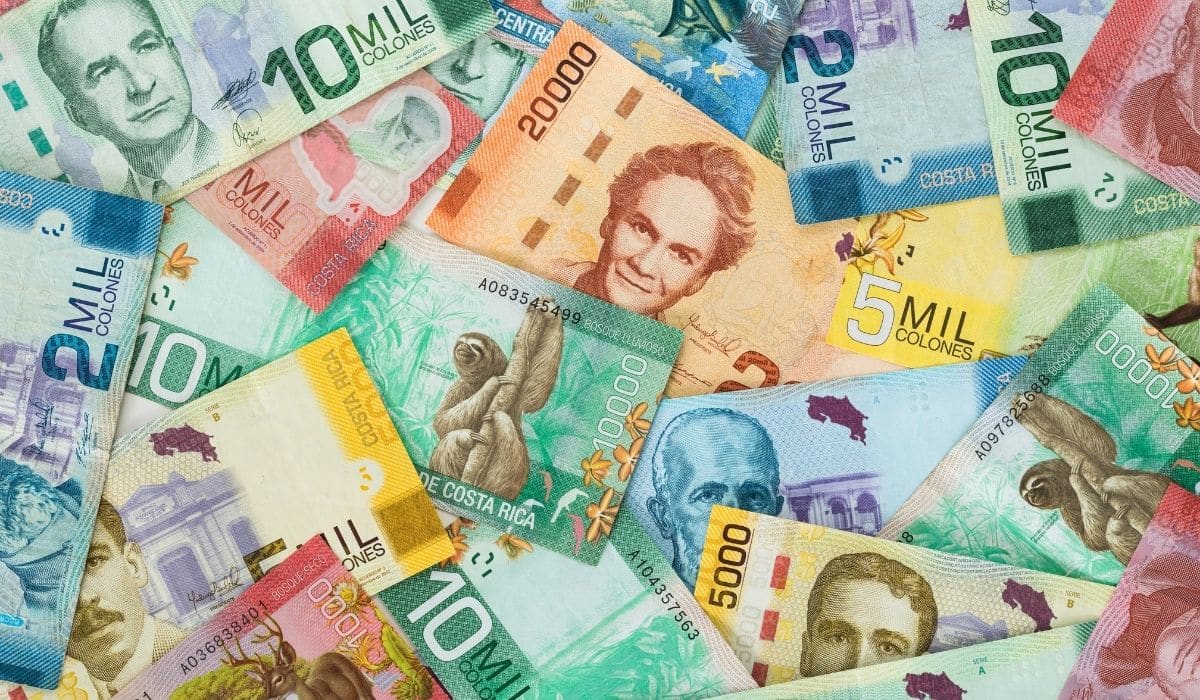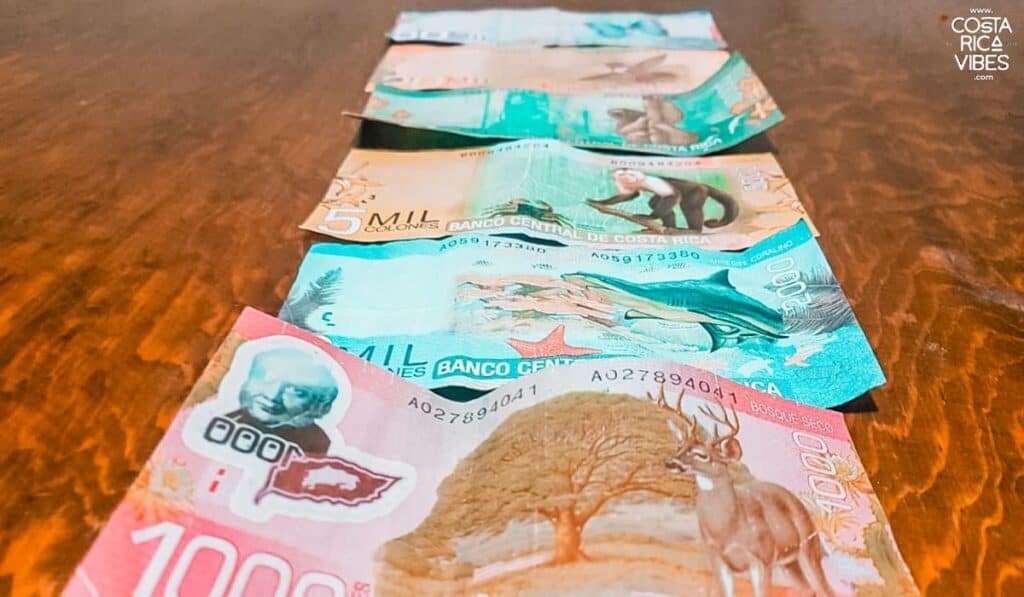Costa Rica Currency: Money Tips
Do you need to exchange money? Are colones or US dollars better to use? What is with tipping? Is it possible to visit Costa Rica on a budget?
We’ve answered all your money-related questions in this guide.

Costa Rica Currency At a Glance
Official Currency: Costa Rica Colon
Where to Exchange Money: ATM’s or from your bank before traveling
Best Way to Pay for Things: Credit card, cash in colones
What is the Official Currency of Costa Rica?
First things first, the national currency in Costa Rica is called colón or colones in plural form.
The bills in Costa Rica come in:
₡ 1,000
₡ 2,000
₡ 5,000
₡ 10,000
₡ 20,000
and 50,000 colones.
Usually, if you get money out of the ATM you will get 5,000 10,000 or 20,000 colones bills. In fact, we had never seen a 50,000 colones bill until recently.

The bills are all different colors as well as slightly different sizes. Every bill has a native Costa Rican animal on it.
I think it is a really pretty currency.
Another cool thing is the 1,000 colones bill is coated with a plastic-like film. If you are going to the beach and want to bring a bit of money for a snack, the 1,000 colones bill is your best option because it won’t get ruined by the water.
The colones coins come in 5, 10, 25, 50, 100, and 500.
WHAT IS THE EXCHANGE RATE OF USD TO COLÓN?
The exchange rate is constantly changing!
This past year the rate has been all over the place.
We like the free currency converter app XE Currency Converter for easily checking the current rate while we are traveling.
What Do Things Cost on Average in Costa Rica
A cup of coffee: ₡1,500
A carton of milk: ₡1,200
A Costa Rican beer at a restaurant: ₡2,200
Can I Use United States Dollars (USD) in Costa Rica?
US dollars are widely accepted throughout the country, but you usually get a much better exchange rate if you pay in colones.
The reason for this is because the exchange rate fluctuates most shops don’t alter their exchange calculations. In other words, you most likely won’t get the most recent currency conversion course.
- If you pay in dollars expect to get colones back as change.
- If you plan on carrying dollars, stick to nothing larger than $20 bills and try to make sure they are in decent condition. People tend to be suspicious of larger bills, especially if they are ripped.
- If you are taking the public buses, shopping at farmers markets, buying things from street vendors etc., they usually only accept colones.
Can I Pay with My Credit Card in Costa Rica?
If you prefer to use your credit card for payments in Costa Rica, that is OK too!
We just have a few pieces of advice for that…
- Most places accept credit cards, but sometimes you will need to have cash for small restaurants. It is always best to ask at restaurants here if they accept credit cards before sitting down for a meal.
- Some stores will have a limit before you are allowed to use credit cards. In other words, usually, you need to spend at least $5 to use your card.
- Thomas knows someone who visited and returned home to find that she had extra charges on her credit card. This is not likely to happen at reputable tourist places, but just a warning.
(You can read about other scams in Costa Rica here)
- Check with your credit card company before traveling to make sure there are no foreign transaction fees.
- It is also a good idea to let your credit card company know that you are traveling so they don’t block your card for suspicious activity.
- Keep in mind that when you pick up your rental car you will need to put a $1,000 deposit on your credit card. Make sure your card limit is high enough for this.
- My dad recently used his credit card to pay for gas here and instead of typing in “22,000 colones” into the machine the attendant typed in “220,000 colones”. Luckily the attendant realized his mistake and was honest (and completely embarrassed). He fixed the problem immediately. Just make sure you check all your receipts before signing the bill.
- The tolls around San Jose are starting to accept credit cards, but it seems to be a slow transition. It is best to still have some cash for these.
How Can I Change US Dollars to Colones?
We think it is best to switch at least some money into colones.
- You may be able to get colones at your local bank before traveling to Costa Rica, but not all banks have them. If you would like to get colones from your bank it is best to call a few weeks before you would like to pick up the colones. The bank may have to order them for you.
- You have the option of exchanging USD to CRC at the airport in the baggage claim area, but it is not the best exchange rate. If you need money right away, I’d suggest getting about $50 exchanged and exchanging the rest somewhere else.
- You can go into the bank here to exchange US dollars to colones. All you need is your passport and they will give you the best rate. Just be warned, the bank tellers don’t always speak great English and sometimes you can wait in line for an hour at the bank. That is not a joke, you seriously can wait an hour or more.
- There are ATM’s located everywhere throughout Costa Rica. Just check with your bank before traveling to see what they will charge you for using an international ATM.
What Should I Know About ATM’s in Costa Rica?
Most towns will have at least one bank or ATM.
Just note that sometimes these ATM’s are located in grocery stores or mini markets.
If you are staying in a small town it is best to check with your hotel ahead of time to make sure that there is an ATM nearby.
- As we already mentioned, check with your bank to see what you will be charged for withdrawing money internationally.
- When you leave an ATM, immediately put your money away and make sure nobody is following you.
- It is always best to visit an ATM in the middle of the day in populated areas.
- We have not heard of people using card scanners in Costa Rica, but that doesn’t mean that it can’t happen. When you use an ATM always check that there aren’t any suspicious parts to the ATM that may be used to copy your card.
- Many ATM’s in Costa Rica give you the option of withdrawing US dollars or colones.
- We suggest getting a bit of money out from an ATM every few days. We don’t like to carry too much money on ourselves.
- It is good to have two bank accounts you can access, just in case. Some of the machines here have chip technology, but not all. It would be horrible for you to plan on using your bank card for your whole trip and then not being able to get money out of the ATM.
- If you are looking for a good bank account that allows you to travel anywhere and not pay ATM fees, I highly suggest Charles Schwab High Yield Checking Account. I switched three years ago and don’t know why I didn’t switch to them earlier. They reimburse all ATM fees to your account and there are no monthly fees. It’s the perfect account for frequent travelers.
Do I Need to Tip in Costa Rica?
Tipping is not required here, but wages aren’t high and the service industry was hit hard from the lack of travelers during COVID.
If you have the means to tip and feel like you have received good service, it is always nice to do so.
– At restaurants, there is a 10% gratuity that is always included. Usually, you will see this on your bill as “servicio.” We usually leave a few extra dollars if we were happy.
Also, just note that they will not just bring the bill out to you at restaurants. You need to ask for it. Here it is considered rude and rushing the customer to just leave the bill without being asked.
– If you take a tour with a great guide it is always nice to give them a small tip. Again, it is not required.
– Typically, if you park in a parking lot there will be an attendant watching cars.
When you leave the lot it is customary to give them a little bit of money (about 500 colones is fine) as a thank you for watching your car.
– It is normal to leave a 10% tip in taxis, if you have good service.
Is Costa Rica Expensive?
The short answer is, yes, Costa Rica is expensive. In fact, it is the most expensive country in Central America.
You can expect to pay prices equivalent to what you would pay in the United States.
However, if you are on a tight budget it is possible to find more affordable options as well.
How Can I Travel Costa Rica on a Budget?
We’ve done a lot of traveling in the country while sticking to a tight budget. Here is what we have discovered.
Save Money on Transportation
The cheapest transportation option is public bus, but it is sometimes difficult to get from one place to another by public bus here.
We suggest checking our guide to backpacking for some good itinerary options by bus as well as checking the destination guide for the place you are planning to visit.
Each guide has tips for taking the bus.
Save Money on Hotels
There are tons of hostels and affordable VRBO listings throughout the country.
All of our destination guides also have a section of suggested budget accommodations.
Save Money on Things to Do
Check out our guide to activities in Costa Rica for tons of budget and free things to do.
I will say, the absolute best free activity is enjoying the thousands of miles of beach on the Pacific and Caribbean coast.
Save Money on Food
To really save money we suggest cooking your own food. We have a guide to grocery stores with some of our favorite easy meals to make here.
Another option is eating at the small restaurants throughout the country known as “sodas.”
At a soda, you will usually be served rice, beans, protein, fried plantain, and a salad for about $8.
Our Final Bits of Money Advice
- At some places, you can get a discount if you pay in cash. It doesn’t hurt to ask!
- Don’t use traveler’s checks. They are too much of a hassle.
- The national parks in Costa Rica are going cash free. You will need to pay with a credit or debit card to enter
- We have never been robbed, but we still suggest keeping a bit of money in various places (socks, different pockets, bra etc) so if you do get robbed you can give them just part of your money.
- There are tolls on the highway from San Jose out to the Pacific coast. We usually use the tolls as a way of getting rid of all of our coins. If you have not switched to colones yet, that is fine. They do accept dollars and will give you colones as change. We suggest paying with a $10 bill and the change in colones will be enough for the rest of the tolls.
You Might Also Like
Complete Guide to Things to Do in Costa Rica
Eating in Costa Rica: Guide to Food
Complete Guide to Booking Accommodations in Costa Rica
….if none of those appeal to you, check out our Must Know Planning Info on Costa Rica for more trip-planning advice
